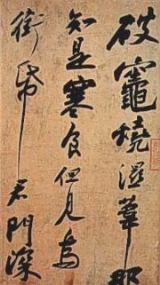
Horizontal and vertical writing in East Asian scripts
Encyclopedia
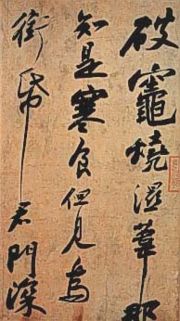
Chinese character
Chinese characters are logograms used in the writing of Chinese and Japanese , less frequently Korean , formerly Vietnamese , or other languages...
, Japanese
Japanese writing system
The modern Japanese writing system uses three main scripts:*Kanji, adopted Chinese characters*Kana, a pair of syllabaries , consisting of:...
and Korean
Hangul
Hangul,Pronounced or ; Korean: 한글 Hangeul/Han'gŭl or 조선글 Chosŏn'gŭl/Joseongeul the Korean alphabet, is the native alphabet of the Korean language. It is a separate script from Hanja, the logographic Chinese characters which are also sometimes used to write Korean...
scripts can be oriented in either direction, as they consist mainly of disconnected syllabic units, each occupying a square block of space. On the other hand the traditional Mongolian script
Mongolian script
The classical Mongolian script , also known as Uyghurjin, was the first writing system created specifically for the Mongolian language, and was the most successful until the introduction of Cyrillic in 1946...
and its offshoots (like Manchu
Manchu alphabet
The Manchu alphabet was used for recording the now near-extinct Manchu language; a similar script is used today by the Xibe people, who speak a language descended from Manchu...
) are written vertically.
Horizontal writing is known in Chinese
Chinese language
The Chinese language is a language or language family consisting of varieties which are mutually intelligible to varying degrees. Originally the indigenous languages spoken by the Han Chinese in China, it forms one of the branches of Sino-Tibetan family of languages...
as hengpai , in Japanese
Japanese language
is a language spoken by over 130 million people in Japan and in Japanese emigrant communities. It is a member of the Japonic language family, which has a number of proposed relationships with other languages, none of which has gained wide acceptance among historical linguists .Japanese is an...
as yokogaki , and in Korean
Korean language
Korean is the official language of the country Korea, in both South and North. It is also one of the two official languages in the Yanbian Korean Autonomous Prefecture in People's Republic of China. There are about 78 million Korean speakers worldwide. In the 15th century, a national writing...
as garosseugi or hoengseo .
Vertical writing is known respectively as shupai , tategaki , or serosseugi or jongseo .
Traditionally, Chinese
Chinese written language
Written Chinese comprises Chinese characters used to represent the Chinese language, and the rules about how they are arranged and punctuated. Chinese characters do not constitute an alphabet or a compact syllabary...
, Japanese, and Korean are written vertically in columns going from top to bottom and ordered from right to left, with each new column starting to the left of the preceding one. The stroke order
Stroke order
Stroke order refers to the order in which the strokes of a Chinese character are written. A stroke is a movement of a writing instrument on a writing surface. Chinese characters are used in various forms in Chinese, Japanese, and in Korean...
and stroke direction of Chinese characters (hanzi in Chinese, kanji
Kanji
Kanji are the adopted logographic Chinese characters hanzi that are used in the modern Japanese writing system along with hiragana , katakana , Indo Arabic numerals, and the occasional use of the Latin alphabet...
in Japanese, hanja
Hanja
Hanja is the Korean name for the Chinese characters hanzi. More specifically, it refers to those Chinese characters borrowed from Chinese and incorporated into the Korean language with Korean pronunciation...
in Korean), Japanese kana
Kana
Kana are the syllabic Japanese scripts, as opposed to the logographic Chinese characters known in Japan as kanji and the Roman alphabet known as rōmaji...
, and Korean Hangul all facilitate writing in this manner. In addition, writing in vertical columns from right to left facilitated writing with a brush in the right hand while continually unrolling the sheet of paper or scroll with the left. In modern times, it has become increasingly common for these languages to be written horizontally, from left to right, with successive rows going from top to bottom, under the influence of European languages such as English.
Now, vertical writing is still used in Japan
Japan
Japan is an island nation in East Asia. Located in the Pacific Ocean, it lies to the east of the Sea of Japan, China, North Korea, South Korea and Russia, stretching from the Sea of Okhotsk in the north to the East China Sea and Taiwan in the south...
, Taiwan
Taiwan
Taiwan , also known, especially in the past, as Formosa , is the largest island of the same-named island group of East Asia in the western Pacific Ocean and located off the southeastern coast of mainland China. The island forms over 99% of the current territory of the Republic of China following...
, Hong Kong
Hong Kong
Hong Kong is one of two Special Administrative Regions of the People's Republic of China , the other being Macau. A city-state situated on China's south coast and enclosed by the Pearl River Delta and South China Sea, it is renowned for its expansive skyline and deep natural harbour...
and Macau
Macau
Macau , also spelled Macao , is, along with Hong Kong, one of the two special administrative regions of the People's Republic of China...
frequently.
Differences between horizontal and vertical writing
Chinese characters, Japanese kana, and Korean hangul can be written horizontally or vertically. There are some small differences in orthographyOrthography
The orthography of a language specifies a standardized way of using a specific writing system to write the language. Where more than one writing system is used for a language, for example Kurdish, Uyghur, Serbian or Inuktitut, there can be more than one orthography...
. In horizontal writing it is more common to use Arabic numerals, whereas Chinese numerals
Chinese numerals
Chinese numerals are characters for writing numbers in Chinese. Today speakers of Chinese use three numeral systems:the ubiquitous Arabic numerals and two indigenous systems....
are more common in vertical text.
In these scripts, the positions of punctuation
Punctuation
Punctuation marks are symbols that indicate the structure and organization of written language, as well as intonation and pauses to be observed when reading aloud.In written English, punctuation is vital to disambiguate the meaning of sentences...
marks, for example the relative position of commas and full stops (periods), differ between horizontal and vertical writing. Punctuation such as the parentheses, quotation marks, book title marks (Chinese), ellipsis mark, dash, wavy dash (Japanese), proper noun mark (Chinese), wavy book title mark (Chinese), emphasis mark, and chōon
Choon
The , also known as ', ', or Katakana-Hiragana Prolonged Sound Mark by the Unicode Consortium, is a Japanese symbol which indicates a chōon, or a long vowel of two morae in length. Its form is a horizontal or vertical line in the center of the text with the width of one kanji or kana character...
mark (Japanese) are all rotated 90 degrees when switching between horizontal and vertical text.
Where a text is written in horizontal format, pages are read in the same order as English books, with the binding at the left and pages progressing to the right. Vertical books are printed the other way round, with the binding at the right, and pages progressing to the left.
Ruby characters, like furigana
Furigana
is a Japanese reading aid, consisting of smaller kana, or syllabic characters, printed next to a kanji or other character to indicate its pronunciation. In horizontal text, yokogaki, they are placed above the line of text, while in vertical text, tategaki, they are placed to the right of the line...
in Japanese or zhuyin in Taiwan Chinese, which provide a phonetic guide for unusual or difficult-to-read characters, follow the direction of the main text. Example in Japanese, with furigana
Furigana
is a Japanese reading aid, consisting of smaller kana, or syllabic characters, printed next to a kanji or other character to indicate its pronunciation. In horizontal text, yokogaki, they are placed above the line of text, while in vertical text, tategaki, they are placed to the right of the line...
in green:
| or |
|
Inserted text in the Roman alphabet is usually written horizontally, or turned sideways when it appears in vertical text, with the base of the characters on the left.
Right-to-left horizontal writing
Historically, vertical writing was the standard system, and horizontal writing was only used where a sign had to fit in a constrained space, such as over the gate of a temple or the signboard of a shop. This horizontal writing is in fact a special case of vertical writing in which each column contains just one character.Therefore, before the end of World War II
World War II
World War II, or the Second World War , was a global conflict lasting from 1939 to 1945, involving most of the world's nations—including all of the great powers—eventually forming two opposing military alliances: the Allies and the Axis...
in Japan, those signs were read right to left.
Today, the left-to-right direction is dominant in all three languages for horizontal writing: this is due partly to the influence of English, and partly to the increased use of computerized typesetting and word processing software, most of which does not directly support right-to-left layout of East Asian languages
However, right-to-left horizontal writing is still seen in these scripts, in such places as signs, on the right-hand side of vehicles, and on the right-hand side of stands selling food at festivals. It is also used to simulate archaic writing, for example in reconstructions of old Japan
Japan
Japan is an island nation in East Asia. Located in the Pacific Ocean, it lies to the east of the Sea of Japan, China, North Korea, South Korea and Russia, stretching from the Sea of Okhotsk in the north to the East China Sea and Taiwan in the south...
for tourists, and it is still found in the captions and titles of some newspapers.
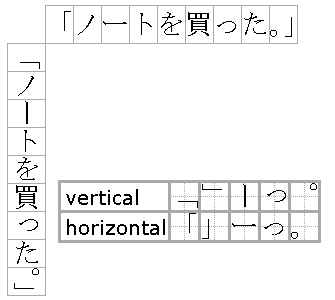 | 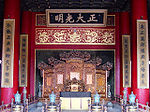 | 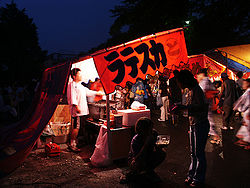 |
Chinese
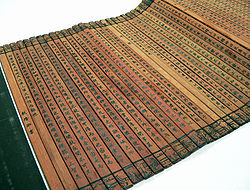
Macau
Macau , also spelled Macao , is, along with Hong Kong, one of the two special administrative regions of the People's Republic of China...
.
The earliest widely known Chinese publication using horizontal alignment was the magazine Science (科學). Its first issue in January 1915 explained the (then) unusual format:
- 本雜誌印法,旁行上左,並用西文句讀點之,以便插寫算術及物理化學諸程式,非故好新奇,讀者諒之。
- This magazine is printed so that it goes sideways from the top left, and is marked with Western punctuation. This is to make the insertion of mathematical, physical and chemical formulae convenient, not for the sake of novelty-hunting. We ask our readers to excuse us.
In the subsequent decades, the occurrence of words in a Western script (predominantly English) became increasingly frequent, and readers begin to appreciate the unwieldiness of rotating the paper at each occurrence for vertically-set texts. This accelerated acceptance of horizontal writing.
With the proliferation of horizontal text, both horizontal and vertical came to be used concurrently. Proponents of horizontal text argued that vertical text in right-to-left columns were smudged easily when written, and moreover demanded greater movement from the eyes when read. Vertical text proponents, on their part, considered horizontal text to be a break from established tradition.
After the success of the communist revolution
Chinese Civil War
The Chinese Civil War was a civil war fought between the Kuomintang , the governing party of the Republic of China, and the Communist Party of China , for the control of China which eventually led to China's division into two Chinas, Republic of China and People's Republic of...
in 1949, the People's Republic of China
People's Republic of China
China , officially the People's Republic of China , is the most populous country in the world, with over 1.3 billion citizens. Located in East Asia, the country covers approximately 9.6 million square kilometres...
decided to use horizontal writing. All newspapers in China
China
Chinese civilization may refer to:* China for more general discussion of the country.* Chinese culture* Greater China, the transnational community of ethnic Chinese.* History of China* Sinosphere, the area historically affected by Chinese culture...
changed from vertical to horizontal alignment on January 1, 1956. In publications, text is run horizontally although book titles on spines and some newspaper headlines remain vertical for convenience. Inscriptions of signs on most state organs are still vertical.
In Singapore
Singapore
Singapore , officially the Republic of Singapore, is a Southeast Asian city-state off the southern tip of the Malay Peninsula, north of the equator. An island country made up of 63 islands, it is separated from Malaysia by the Straits of Johor to its north and from Indonesia's Riau Islands by the...
, vertical writing has also become rare. In Taiwan
Taiwan
Taiwan , also known, especially in the past, as Formosa , is the largest island of the same-named island group of East Asia in the western Pacific Ocean and located off the southeastern coast of mainland China. The island forms over 99% of the current territory of the Republic of China following...
, Hong Kong
Hong Kong
Hong Kong is one of two Special Administrative Regions of the People's Republic of China , the other being Macau. A city-state situated on China's south coast and enclosed by the Pearl River Delta and South China Sea, it is renowned for its expansive skyline and deep natural harbour...
, Macau
Macau
Macau , also spelled Macao , is, along with Hong Kong, one of the two special administrative regions of the People's Republic of China...
, and among older overseas Chinese
Overseas Chinese
Overseas Chinese are people of Chinese birth or descent who live outside the Greater China Area . People of partial Chinese ancestry living outside the Greater China Area may also consider themselves Overseas Chinese....
communities, horizontal writing has been gradually adopted since the 1990s. By the early 2000s, most newspapers in these areas had switched to left-to-right horizontal writing, either entirely or in a combination of vertical text with horizontal left-to-right headings.
Japanese
Horizontal text came in to Japanese in the Meiji era, when the Japanese began to print Western language dictionaries. Initially they printed the dictionaries in a mixture of horizontal Western and vertical Japanese text, which meant readers had to rotate the book ninety degrees to read the Western text. Because this was unwieldy, the idea of yokogaki came to be accepted. One of the first publications to partially use yokogaki was a German to Japanese dictionary (袖珍挿図独和辞書, Shūchinsōzu Dokuwa Jisho, "pocket illustrated German to Japanese dictionary") published in 1885 (Meiji 18).At the beginning of the change to horizontal alignment in Meiji era Japan, there was a short-lived form called migi yokogaki (右横書き, literally "right horizontal writing"), in contrast to hidari yokogaki, (左横書き, literally "left horizontal writing"), the current standard. This resembled the right-to-left horizontal writing style of languages such as Arabic
Arabic language
Arabic is a name applied to the descendants of the Classical Arabic language of the 6th century AD, used most prominently in the Quran, the Islamic Holy Book...
with line breaks on the left. It was probably based on the traditional single-row right-to-left writing. This form was never widely used except for pre-WWII official documents (like banknotes), and has not survived outside of some temple name signs.
Korean

In 1988, The Hankyoreh became the first Korean newspaper to use horizontal writing, and after 1990, all other major newspapers followed suit. Today, no major Korean newspapers run text vertically.
Simplified Chinese

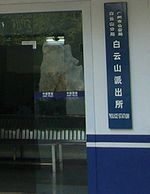
Mainland China
Mainland China, the Chinese mainland or simply the mainland, is a geopolitical term that refers to the area under the jurisdiction of the People's Republic of China . According to the Taipei-based Mainland Affairs Council, the term excludes the PRC Special Administrative Regions of Hong Kong and...
, where the Simplified Chinese orthographical reform has been adopted, vertical writing is now very rare, more so in print than in writing and signage. Most publications are now printed in horizontal alignment, like English. Horizontal writing is written left to right in the vast majority of cases, with a few exceptions such as bilingual dictionaries of Chinese and right-to-left scripts like Arabic, in which case Chinese may follow the right-to-left alignment. Right-to-left writing direction can also often be seen on the right side of tourist buses, as it is customary to have the text run (on both sides of the vehicle) from the front of the bus to its rear.
Vertical alignment is generally used for artistic or aesthetic purposes (e.g. on logos and book covers), in scholarly works on Classical Chinese literature, or when space constraints demand it (e.g. on the spines of books and in labelling diagrams). Naturally, vertical text is also used on signs that are longer than they are wide; such signs are the norm at the entrances of schools, government offices and police stations as in the example to the right. Calligraphy - in Simplified or Traditional Chinese - is invariably written vertically. Additionally, vertical text may still be encountered on some business card
Business card
Business cards are cards bearing business information about a company or individual. They are shared during formal introductions as a convenience and a memory aid. A business card typically includes the giver's name, company affiliation and contact information such as street addresses, telephone...
s and personal letters in China
Japanese and Traditional Chinese
Both horizontal and vertical writing are used in Japan, as well as in Hong KongHong Kong
Hong Kong is one of two Special Administrative Regions of the People's Republic of China , the other being Macau. A city-state situated on China's south coast and enclosed by the Pearl River Delta and South China Sea, it is renowned for its expansive skyline and deep natural harbour...
, Macau
Macau
Macau , also spelled Macao , is, along with Hong Kong, one of the two special administrative regions of the People's Republic of China...
and Taiwan
Taiwan
Taiwan , also known, especially in the past, as Formosa , is the largest island of the same-named island group of East Asia in the western Pacific Ocean and located off the southeastern coast of mainland China. The island forms over 99% of the current territory of the Republic of China following...
where the Traditional Chinese orthography is used. Traditional Chinese is also used in China in a few limited contexts, such as some books on ancient literature, or as an aesthetic choice for some signs on shops, temples, etc. In those contexts, both horizontal and vertical writing are used as well.

Manga
Manga is the Japanese word for "comics" and consists of comics and print cartoons . In the West, the term "manga" has been appropriated to refer specifically to comics created in Japan, or by Japanese authors, in the Japanese language and conforming to the style developed in Japan in the late 19th...
, and many other forms of writing. Because it goes downwards, vertical writing is invariably used on the spines of books. Some newspapers combine the two forms, using the vertical format for most articles but including some written horizontally, especially for headline
Headline
The headline is the text at the top of a newspaper article, indicating the nature of the article below it.It is sometimes termed a news hed, a deliberate misspelling that dates from production flow during hot type days, to notify the composing room that a written note from an editor concerned a...
s. Musical notation
Musical notation
Music notation or musical notation is any system that represents aurally perceived music, through the use of written symbols.-History:...
for some Japanese instruments such as the shakuhachi
Shakuhachi
The is a Japanese end-blown flute. It is traditionally made of bamboo, but versions now exist in ABS and hardwoods. It was used by the monks of the Fuke school of Zen Buddhism in the practice of...
is written vertically.
Horizontal writing is easier for some purposes; academic texts are sometimes written this way since they often include words and phrases in other languages, which are more easily incorporated horizontally. Scientific
Science
Science is a systematic enterprise that builds and organizes knowledge in the form of testable explanations and predictions about the universe...
and mathematical
Mathematics
Mathematics is the study of quantity, space, structure, and change. Mathematicians seek out patterns and formulate new conjectures. Mathematicians resolve the truth or falsity of conjectures by mathematical proofs, which are arguments sufficient to convince other mathematicians of their validity...
texts are nearly always written horizontally, since in vertical writing equations must be turned sideways, making them more difficult to read.
Similarly, English language textbooks, which contain many English words, are usually printed in horizontal writing. This is not a fixed rule, however, and it is also common to see English words printed sideways in vertical writing texts.
Computer text is usually presented in horizontal format; see Japanese language and computers
Japanese language and computers
In relation to the Japanese language and computers many adaptation issues arise, some unique to Japanese and others common to languages which have a very large number of characters. The number of characters needed in order to write English is very small, and thus it is possible to use only one byte...
.
Business cards in Japan (meishi
Meishi
A is a Japanese business card. The presentation of one's meishi to another person is more formal and ritualistic than in the west.- Presentation :A person is expected to present their meishi upon meeting a new business acquaintance...
) are often printed vertically in Japanese on one side, and horizontally in English on the other. Postcards and handwritten letters may be arranged horizontally or vertically, but the more formal the letter the more likely it is to be written vertically. Envelope addresses are usually vertical, with the recipient's address on the right and the recipient's name in the exact centre of the envelope. See also Japanese etiquette.
Calligraphy
In East Asian calligraphyEast Asian calligraphy
East Asian calligraphy is a form of calligraphy widely practised and revered in the Sinosphere. This most often includes China, Japan, Korea, and Vietnam. The East Asian calligraphic tradition originated and developed from China. There is a general standardization of the various styles of...
, vertical writing remains the dominant direction. This is true even for calligraphy done in Simplified Chinese.
Comics
Japanese comics, also known as mangaManga
Manga is the Japanese word for "comics" and consists of comics and print cartoons . In the West, the term "manga" has been appropriated to refer specifically to comics created in Japan, or by Japanese authors, in the Japanese language and conforming to the style developed in Japan in the late 19th...
, tend to use vertical direction for text. Manga frames tend to flow in right-to-left horizontal direction. Frames in yonkoma manga
Yonkoma
thumb|right|150px|Traditional Yonkoma layout, a comic-strip format, generally consists of gag comic strips within four panels of equal size ordered from top to bottom...
tend to flow in a vertical direction. Page ordering is the same as books that use vertical direction: from right to left. Frames that are chronologically before or after each other use less spacing in between as a visual cue.
In some cases, horizontal writing may be used to indicate that a character is actually speaking in English instead of Japanese.
Some publishers that translate manga into European languages may choose to keep the original page order (a notable example is Shonen Jump
Shonen Jump (magazine)
Shonen Jump, officially stylized SHONEN JUMP and abbreviated SJ, is a shōnen manga anthology published in North America by Viz Media. It debuted in November 2002 with the first issue having a January 2003 cover date...
magazine), while other publishers may reverse the page flow with use of mirrored pages.
Korean

Korea
Korea ) is an East Asian geographic region that is currently divided into two separate sovereign states — North Korea and South Korea. Located on the Korean Peninsula, Korea is bordered by the People's Republic of China to the northwest, Russia to the northeast, and is separated from Japan to the...
, vertical writing is rare. Modern Korean is usually written in left-to-right horizontally. Vertical writing is only used when the writing space is long vertically and narrow horizontally. For example, titles on the spines of books are usually written vertically. When a foreign language film is subtitled into Korean, the subtitles are sometimes written vertically at the right side of the screen.
In the Standard language of South Korea
South Korea
The Republic of Korea , , is a sovereign state in East Asia, located on the southern portion of the Korean Peninsula. It is neighbored by the People's Republic of China to the west, Japan to the east, North Korea to the north, and the East China Sea and Republic of China to the south...
, punctuation marks are used differently in horizontal and vertical writing. Western punctuation marks are used in horizontal writing and the Japanese-style punctuation marks are used in vertical writing. However, vertical writing using Western punctuation marks is sometimes found.
Vietnamese
In modern VietnamVietnam
Vietnam – sometimes spelled Viet Nam , officially the Socialist Republic of Vietnam – is the easternmost country on the Indochina Peninsula in Southeast Asia. It is bordered by China to the north, Laos to the northwest, Cambodia to the southwest, and the South China Sea –...
, vertical writing is rare. Modern Vietnamese, written using the Quốc Ngữ script, is always written horizontally left-to-right. Traditionally, vertical writing in Vietnamese was only used for Chữ Nôm and Chữ Nho but a style of writing Quốc Ngữ vertically has emerged. Before Chữ Nôm and Chữ Nho became unpopular, they were also written horizontally both right-to-left and left-to-right.
Traditionally the Chữ Nôm and Chữ Nho system did not employ punctuation marks. Only at the beginning of the twentieth century some authors started to use punctuation marks as are found for example in modern Japanese.
Mongolian
Traditional Mongolian Script and its offshoots including Manchu script are rendered vertically. Characters within Mongolian text that can only be rendered horizontally are rotated by 90 degrees.The columns are read from left to right.
Vertical writing and computers
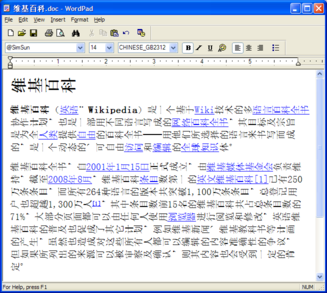
Latin alphabet
The Latin alphabet, also called the Roman alphabet, is the most recognized alphabet used in the world today. It evolved from a western variety of the Greek alphabet called the Cumaean alphabet, which was adopted and modified by the Etruscans who ruled early Rome...
. Today, most computer programs do not fully support the vertical writing system; however, most advanced word processing and publication software which target the East Asian region support the vertical writing system either fully or to a limited extent.
Even though vertical text display is generally not well supported, composing vertical text for print has been made possible. For example, on Asian editions of Windows, Asian fonts are also available in a vertical version, with font names prefixed by "@". Users can compose and edit the document as normal horizontal text. When complete, changing the text font to a vertical font converts the document to vertical orientation for printing purposes.
Vertical text and layout on World Wide Web
Since the late 1990s, W3C (World Wide Web Consortium) has been drafting Cascading Style Sheets properties to enable display on the Web of the various languages of the world according to their heritage text directions. Their latest efforts in 2011 show some revisions to the previous format for the Writing Mode property which provides for vertical layout and text display. The former format "writing-mode:tb-rl" has been revised as "writing-mode: vertical-rl".Among Web browsers, Internet Explorer probably is the only one that has been supporting vertical text and layout coded in HTML. Starting with IE 5.5 in 2000, Microsoft has enabled the writing mode property as a "Microsoft extension to Cascading Style Sheets (CSS)".
See also
- East Asian calligraphyEast Asian calligraphyEast Asian calligraphy is a form of calligraphy widely practised and revered in the Sinosphere. This most often includes China, Japan, Korea, and Vietnam. The East Asian calligraphic tradition originated and developed from China. There is a general standardization of the various styles of...
- Genkō yōshiGenko yoshiis a type of Japanese paper used for writing. It is printed with squares, typically 200 or 400 per sheet, each square designed to accommodate a single Japanese character or punctuation mark...
- Stroke orderStroke orderStroke order refers to the order in which the strokes of a Chinese character are written. A stroke is a movement of a writing instrument on a writing surface. Chinese characters are used in various forms in Chinese, Japanese, and in Korean...
- Bi-directional textBi-directional textBi-directional text is text containing text in both text directionalities, both right-to-left and left-to-right . It generally involves text containing different types of alphabets, but may also refer to boustrophedon, which is changing text directionality in each row.Some writing systems of the...
- Writing systemWriting systemA writing system is a symbolic system used to represent elements or statements expressible in language.-General properties:Writing systems are distinguished from other possible symbolic communication systems in that the reader must usually understand something of the associated spoken language to...
External links
- W3C's work in progress: "CSS Writing Modes Module Level 3"
- Grinols, Mark. "Using vertical layout in Internet Explorer 5.5" (Microsoft Corporation, October 2000)
- "Explaining why Chinese characters move vertically (tb-rl)" (a passage from Ishikawa Kyuyo's book)
- Unicode Technical Note #22 Robust Vertical Text Layout

